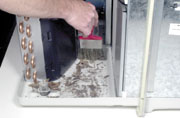Regular inspection and cleaning could help these units last almost twice as long in their typical hotel/motel applications, noted Bench, PTAC marketing and sales manager. And their cooling and heating will be much more effective over the life of the unit.

CLEAN IT UP
“The unit should be cleaned once a year, typically going into the cooling season,” he stated. “And your air filters should be cleaned every 30 days.”In some environments, however, “If construction is going on down the road or if you’re located by the coast, you might need to clean the unit twice a year to get any kind of longevity out of it.”
But users don’t always pay attention to the need for cleaning. “Preventive maintenance is something we’ve been working on very hard for the last couple of years,” said Bench.
Very often, hotel/motel operators will buy these units, “put them in the wall, and run them until they die,” he said. “Instead of getting at least 10 or 12 years out of them, they’re making a capital expenditure for new units every six or seven years.
“It’s just like your car. If you don’t change the oil, it’s not going to last.”
What’s more, the design life of the units is actually 15 years, said Bench. That means every component undergoes testing to ensure that level of service life. “Component by component, it’s a 15-year design life.”
To achieve higher efficiency levels, manufacturers are making their coils more and more dense — adding more fins and placing them closer together — “so just a little bit of dirt and blockage can create stress on the compressor,” he pointed out. Thus, the equipment is better today, but it requires more attention to maintenance to keep it running at peak efficiency.
MAINTENANCE CHECKS
To maintain the performance of a PTAC unit, Carrier recommends a 10-step preventive maintenance program:1. Wash the condenser coil from the inside out.
“We recommend that you pretreat the coil to loosen up dirt and debris before cleaning,” Bench said. A low-pressure washer should be used for coil cleaning. “A high-pressure washer would damage the fins,” he said.
Spray the coil-cleaning solution evenly across the coils, making sure the coils are thoroughly saturated. Rinse the coils completely with low-velocity, clean water.

Again, use a low-pressure washer.
3. Wash the base pan.
Thoroughly clean the base pan and drain passages. Make sure all debris is removed from the drain valve. Allow components to air dry before reassembling the unit.
4. Clean or install new air filters as appropriate.
The indoor and vent air filters should be cleaned once per month. Filters that are not cleaned will become clogged and restrict airflow, which can lead to major component damage. If an air filter becomes torn, has holes, or other damage, replace it with a new one.
5. Clean the front cabinet, blower wheel, and heater assembly.
The cabinet should be cleaned with a mild detergent. Cleaning the exterior enhances the unit’s appearance and removes particles that may enter the air system.
Mild detergents reduce electrostatic charges on the grille. Use the detergent sparingly and apply a clean cloth to gently wipe exterior surfaces. Be careful not to push dirt into the interior of the unit. Wall sleeve surfaces should also be wiped clean.
Dirt and buildup on the blower wheel can reduce the efficiency of the unit. Use a soft bristle brush to gently brush away dried material. Vacuum loose debris, as well as any dust or lint off of the heater assembly.

Replace damaged or missing pushbuttons or knobs.
7. Oil the fan motor if necessary.
Newer units may not require this.
8. Inspect the cord and receptacle, and secure electrical connections.
Make sure the unit is safe to operate.
9. Check that the front cover/grille is properly mounted and not damaged, and that the wall sleeve installation is correct.
Check that the wall sleeve is level. Most wall sleeves are self pitching, “so if it’s level, it’s pitching correctly outside, so that water flows outward and not into the room,” said Bench. Also, inspect the caulk or seal around the wall sleeve to make sure outside air penetration and water infiltration are prevented.
10. Verify proper unit operation in both the cooling and heating modes.
When it comes to a PTAC, abuse it and lose it. Maintain it, and … well, users could very well get much longer service life than they expected.
For more information, contact Bench at ronald.bench@carrier.utc.com (e-mail) or visit www.lodgingac.carrier.com (website).
Publication date: 06/10/2002




